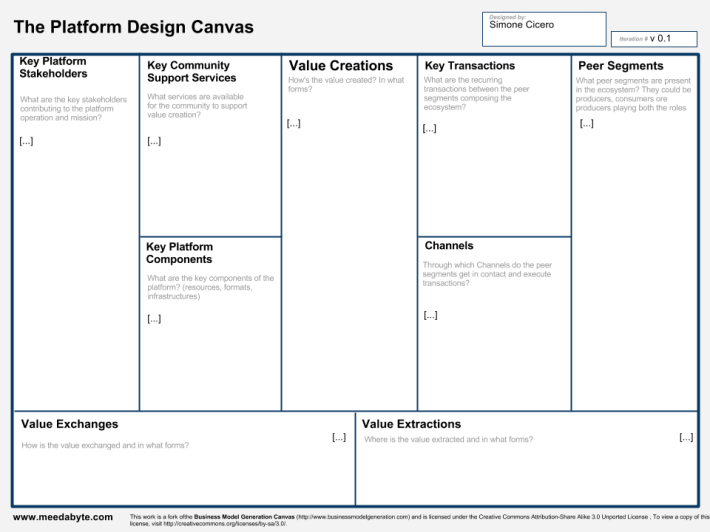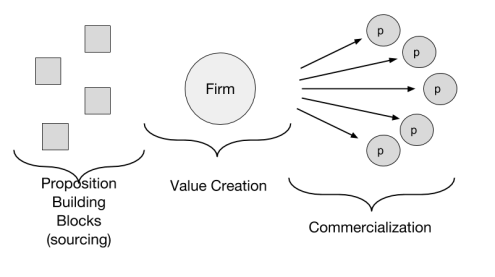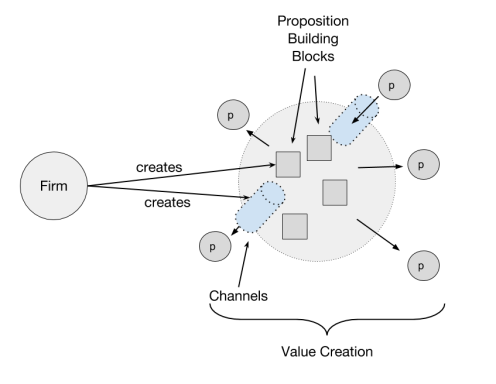See an updated post on the PLATFORM DESIGN TOOLKIT here: https://meedabyte.com/2013/11/06/the-platform-design-toolkit-is-in-the-making/
(The Italian translation follows / In Italiano in fondo al post)
In just a few days from now, from the 2nd to the 4th of July, I will be back in Barcelona, at the Escuela Superior de Ingeniería de Diseño and Barcelona – ELISAVA to hold, for the first time – on the 3rd of July – a workshop I’m working on since a while. I will have the possibility to repeat the Workshop also in October, in Italy, during Frontiers of Interaction 2013, an established conference about innovation in Italy.
I’m saying back *again* in Barcelona since just a few days ago I spent some wonderful days there: in fact I attended the third Ouishare Summit, during which I had the opportunity and duty to moderate the global barcamp with more than 60 participants. It was a unique opportunity that made the pair with the experience I had in New York for the Open Source Hardware Documentation Jam. I had no chance to tell you about it, but you can check the Open Source Hardware Association Blog where, a few days ago, I had the chance to share a report.
The discussion in Ouishare right now, partly as a result of the working sessions that were held during the barcamp, took a strong a step forward. Today we are in fact designing an open governance and incorporation model which will be hopefully efficient, open and inclusive. We are seeking to analyze and compare the experiences from the many players who already had successful experiences in creating platforms for open and social innovation. Important cases are those of Mozilla Foundation, OKFN, my friends from Cocoon Projects or even the pioneers of horizontal organizations playing well on the market such as Valve Software or Menlo Innovations.
But let’s come back to the workshop. “The Future Proof Enterprise: how to create Resilient, Meaningful and Enduring Businesses” will be the first opportunity for me to present in public the Platform Design Canvas. This canvas is a fork of the Business Model Canvas which aims to facilitate the design of business, but I would say also products or organizations (as in the case of Ouishare) looking at them as platforms for value creation. It’s nothing more (or less) than a tool for platform design.
These days it’s quite hard not to notice the undergoing transition regarding the relation between organizations and the market: all is switching from one-way relationships to networked business. A recent article by Steve Denning correlated data from several books in print in the last two years (describing them as a canon), all directed to highlight a necessary transformation both in terms of management, mission and value proposition (very worth reading, see it here).
I’m pretty much convinced that such as canvas may be really useful to assess the value of existing strategies (adaptation) as well as in creating new ones, in the same way as the Business Model Canvas created a few years ago by Alex Osterwalder was a very efficient tool for creativity and innovation in the field of linear business models.
The canvas in is only a Draft (version 0.1) and is currently in live edit: the file is available for comments for anyone and someone already begun to give comments and contributions for its improvement.
I think it’s useful be useful to describe the main assumptions behind this first version of the canvas so as to clarify the point of view behind the overall idea:
-
From customer segments to segments of peers: the first principle behind the canvas and the vision of the business as a platform is to understand how the role of the consumer has changed radically from at least two points of view. Users now increasingly want an active role in the process of consuming and often become producers or configurators of goods and services when they get a chance.
-
Among these peer groups, transactions increasingly happen with exchange of value. These transactions may take place outside of the platform or, more desirably, within the same, through appropriate channels. When these channels do not exist they should be created and cured by those stakeholders who manage the platform: their mission is to spot the emergence of informal transactions and economies that can be modeled and grown around optimized channels.
-
Each platform has a reference community, composed of all the peer segments that interact with it. Each platform should provides resources and services to support the creation of value.
-
The platform operator can extract a (fair) quantity of value in case significant value generation occurs through the platform and is strictly linked to the same.
-
Exchanges, in the ecosystem generated around the platform, can be done with different currencies (typically: money, gift/barter and various forms of reputation): for this reason we speak of flows (generation, trade and extraction) of value.
Looking at businesses and products from a platform perspective implies a substantial transition from the vision of a linear flow that goes from the producer to consumers to the vision of a networked business,where the value is co-created by many actors, a difference that Sangeet framed properly in this post with the distinction between Pipes and Platforms.
How does the target change then? In the linear interpretation of business, value creation takes place within the firm, which turns blocks and primary products in complex products and services, which then submits to the market in a shareholder value maximization process.
In the interpretation of the business as a platform, the company’s goal – and of the other stakeholders responsible for the platform – becomes to maximize the opportunities of value exchange between peers (and in general peer segments) through two core activities: the creation of blocks, modules and contexts for creation (eg, APIs, Tools, Contests, Conferences …) and the identification, establishment and improvement of channels for the exchange of value between peers (eg: marketplaces).
I based this canvas on Alex Osterwalder’s Business Model Canvas because of two main reasons. First, I think it’s important not to reinvent the wheel, secondly I did it in order to facilitate people’s familiarization of with the tool. The Business Model Canvas definitely has the problem of being too linear to correctly frame all the actors of a “networked” company, product or organization. However, my experience of using the business model canvas in contexts related, for example, to open business platform (such as that of openpicus, an open hardware company I’m advising) showed me that it is not impossible (for example, using a color code) to model different non-linear relations in a linear canvas.
I find it extremely important, as I said, to take advantage of the cognitive familiarity that many have with the ingenious tool created by Osterwalder and I think this may be decisive for the adoption, as the history of Ash Mayura’s Lean Canvas (the most popular iteration / fork of the BM Canvas so far) demonstrates.
This post is only the first in a series of posts that I will publish in the coming days about the canvas and platform design in general. In the meantime, I remind you that you can give feedbacks commenting directly on the template available here: http://goo.gl/wz615 .
In addition you can use the #PDCanvas hashtag to share your impressions, comments and, why not, concerns about this approach.
ADD-ON: here’s the presentation I gave at the Design Thinking Week, it gives you a bit of context:
ADD-ON again: here’s a great video that the folks at DNSEE made at Frontiers of Interaction ’13 (where I hosted a megaworkshop on the Platform Design Canvas with more than sixty participants). This video is great to explain the Canvas and the context in just 4 minutes so it’s good to add it here as a corollary explanation:
You should follow me on twitter here!
And, if you liked the post, please tweet this!
Segue traduzione in Italiano
Il Platform Design Canvas: uno strumento di Business Design
Tra ormai pochissimi giorni, esattamente dal 2 al 4 Luglio, sarò di nuovo a Barcellona, presso la Escuela Superior de Diseño e Ingeniería de Barcelona ELISAVA per tenere per la prima volta – il giorno 3 – un workshop su cui sto lavorando da un po’ di tempo, che avrò poi la facoltà di ripetere a Ottobre anche in Italia, a Frontiers of Interaction 2013.
Di nuovo perché solo qualche giorno fa ho passato qualche splendida giornata a Barcellona per partecipare al terzo summit Ouishare, durante il quale ho avuto modo di moderare un barcamp con più di 60 partecipanti, una opportunità unica che ha fatto il paio con l’esperienza newyorchese della Open Source Hardware Documentation Jam che ho avuto modo di raccontare sul blog dell’Open Source Hardware Association qualche giorno fa.
La discussione in Ouishare, anche a seguito delle sessioni di lavori che si sono tenute durante il barcamp, è decisamente salita di tono e oggi ci troviamo a progettare un modello di open governance e incorporazione che speriamo efficiente, aperto e inclusivo e che ci sta vedendo analizzare e comparare le esperienze dei tanti che hanno già creato esperienze vincenti come la Mozilla Foundation, OKFN, gli amici di Cocoon Project o anche i pionieri delle organizzazioni orizzontali di Valve Software.
Per tornare al workshop in questione: “The Future Proof Enterprise: how to create Resilient, Enduring and Meaningful Businesses” va detto che presenterò per la prima volta in pubblico il Platform Design Canvas, un fork del Business Model Canvas che ha come obiettivo facilitare la progettazione del business, dei prodotti ma direi anche delle organizzazioni guardando a loro come piattaforme di creazione di valore. In questo senso ne vedo una utilità anche nella progettazione della piattaforma di Ouishare.
È difficile non notare che è in atto una transizione che vede il superamento dei rapporti unidirezionali tra business, organizzazioni e mercato. Un recente articolo di Steve Denning ha messo in correlazione diversi libri dati alle stampe negli ultimi due anni (descrivendoli addirittura come un canone), tutti diretti a evidenziare una trasformazione necessaria sia in termini di management che di mission e value proposition.
Sono convinto che uno strumento come il canvas potrà essere utile a valutare le value strategie esistenti (adattandole) e a crearne di nuove, così come il Business Model Canvas creato da Alex Osterwalder qualche anno fa è stato strumento molto efficiente di creazione e innovazione di Business models.
Il canvas in questione è solo in Draft (versione 0.1 per la precisione) ed è attulmente in live edit, il file è disponibile per i commenti per chiunque e qualcuno ha già cominciato a dare commenti e contributi per il suo miglioramento.
Può essere utile descrivere le principali assunzioni dietro questa prima versione del canvas così da chiarire il punto di vista dietro l’idea stessa del canvas:
-
Da segmenti di clientela a segmenti di pari: il primo principio dietro il canvas e la visione del business come piattaforma è quello di comprendere come la figura del consumatore sia cambiata radicalmente da almeno due punti di vista. Abbiamo un utente che sempre più spesso desidera un ruolo attivo nel processo di consumo e diventa spesso un produttore o configuratore di beni, servizi quando ne ha la possibilità.
-
Tra questi gruppi di pari, avvengono sempre più frequentemente delle transazioni con scambio di valore. Queste transazioni possono avvenire all’esterno della piattaforma o, più auspicabilmente, all’interno della stessa, attraverso gli appropriati canali. Quando questi canali non esistono vanno creati e curati da chi gestisce la piattaforma.
-
Ogni piattaforma ha una community di riferimento, composta da tutti i peer segments che interagiscono con la stessa. Ogni piattaforma offre risorse e servizi a supporto della una creazione di valore
-
Il gestore della piattaforma può estrarre un (equo) quantitativo di valore, a fronte di una rilevante generazione di valore che avvenga mediante la piattaforma e in maniera esclusivamente legata alla stessa
-
Gli scambi nell’ecosistema che si genera intorno alla piattaforma avvengono mediante diverse valute (tipicamente: denaro, dono/baratto e differenti forme di reputazione): per questo parliamo di flussi (generazione, scambio e estrazione) di valore.
Guardare al business e ai prodotti da punto di vista della piattaforma si basa su una sostanziale transizione, un passaggio dalla visione lineare fatta di flussi che si muovono dal produttore al consumatore al networked business, dove il valore è co-creato da numerosi attori: una differenza che l’amico Sangeet inquadra correttamente con la distinzione tra Pipes e Platforms
Come cambia dunque l’obiettivo? Nell’interpretazione lineare del business la creazione di valore avviene dentro l’azienda, che trasforma blocchi e prodotti primari in prodotti e servizi complessi, che poi sottopone al mercato.
Nell’interpretazione del business come piattaforma, l’obiettivo dell’azienda – e degli altri stakeholders responsabili della piattaforma – diviene quello di massimizzare le opportunità di scambio di valore tra peers (e peer segments) attraverso due attività centrali: la creazione di blocchi, moduli e contesti per la creazione (es: API, Tools, …) e l’individuazione, l’istituzione e il miglioramento di canali per lo scambio di valore tra pari (es: marketplaces).
Ho scelto di basare il canvas sul template del Business Model Canvas di Alex Osterwalder perchè credo sia molto importante non reinventare continuamente la ruota, anche allo scopo di facilitare la familiarizzazione delle persone con gli strumenti. Il Business Model Canvas ha sicuramente il problema di essere una struttura troppo lineare che si presta poco a modellare tutti gli attori di una “networked” company, product o organization. Tuttavia, la mia esperienza nell’utilizzare il business model canvas in contesti di open business in cui l’aspetto piattaforma era presente mi ha mostrato che non è impossibile (ad esempio utilizzando un codice di colori) modellare diverse relazioni non-lineari in un canvas lineare.
Trovo invece estremamente importante, come detto, sfruttare la familiarità cognitiva che molti hanno nei confronti del geniale strumento creato da Osterwalder e credo che questa possa essere decisiva per l’adozione, come dimostra la storia del Lean Canvas di Ash Mayura, prima e più famosa iterazione/fork del più famoso BM Canvas.
Questo post è solo il primo di una serie di post che pubblicherò nei prossimi giorni a proposito del canvas e del business platform design nel frattempo vi ricordo che potete dare feedbacks direttamente commentando il template disponibile qui. Inoltre potete usare l’hastag #PDCanvas per condividere le vostre impressioni, considerazioni e perchè no, perplessità riguardo questo approccio.
ADD-ON: Questa è la presentazione che ho I tenuto prima del workshop alla Design Thinking Week, vi da un po’ di contesto:





Great work!
Pingback: Andrew Karpie » The Platform Design Canvas: a tool for Business Design | Meedabyte
Pingback: Variante del business model canvas dedicata alle piattaforme | LoL marketing
Pingback: A Systematization of Methodologies in Startup Thinking | Meedabyte
Pingback: Back from Societing Summer School: Envisioning the Rural Hub | Meedabyte
Really nice with it’s all words. Thanks author. I become very helped.
Pingback: Digital Evolutions: Startups, Platforms and Ecosystems | Meedabyte
Pingback: Un Update sul Platform Design Toolkit | Simone Cicero